Euphorbia Mila: description, reproduction, pruning and care
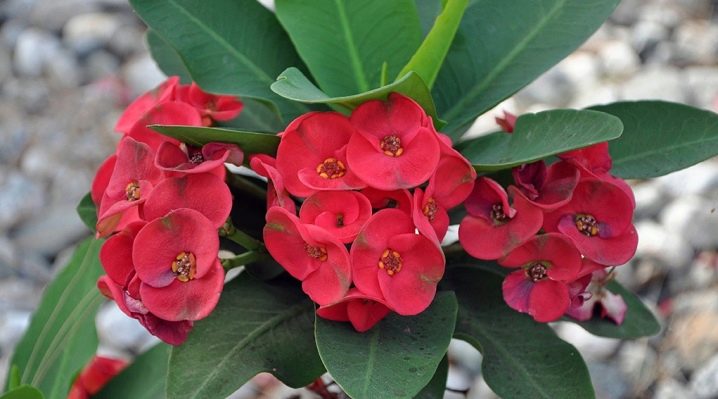
Most pet flower lovers do not know the exact names of their green pets. One of these common plants is euphorbia. There are more than a dozen varieties of this plant. The article will focus on its brightest representative - Milkweed Mil, which belongs to perennial shrubs and is a succulent. To amateur flower growers, it is also known as euphorbia beautiful, euphorbia, euphorbia Milius.
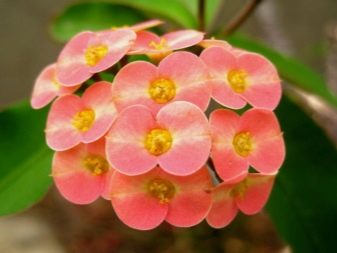
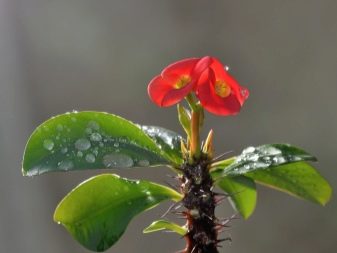
Peculiarities
The plant got its name from the French baron Milius, who lived at the beginning of the 19th century. An ancient legend says that a crown of thorns was made from this plant, which was put on the head of Jesus Christ. Under natural conditions, it grows as a bush with a gray, slightly ribbed stem. Plant height reaches two meters. Young elliptical leaves are born at the tops of the shoots. Each leaf has two bracts, which eventually transform into very sharp spines. During the growing up of the plant, the leaves fall off, only thorns remain. Outwardly, it looks like a bare stem, studded with thorns, and only at the top are islands of pale green shiny leaves.
In Russia, euphorbia is grown as a houseplant in apartments, private houses, greenhouses or year-round heated greenhouses. In such conditions, the flower is not able to achieve its natural natural two-meter growth, as it grows very slowly, adding only a couple of centimeters in growth annually. It is relatively unpretentious, but very decorative due to flowering. Grouped inflorescences of four flowers crown all the tops of the plant and blaze in bright red, delightful hues.
Euphorbia Mila looks great not only in single plantings, but also in group ones, together with other succulent plants, different in height and flowering time.
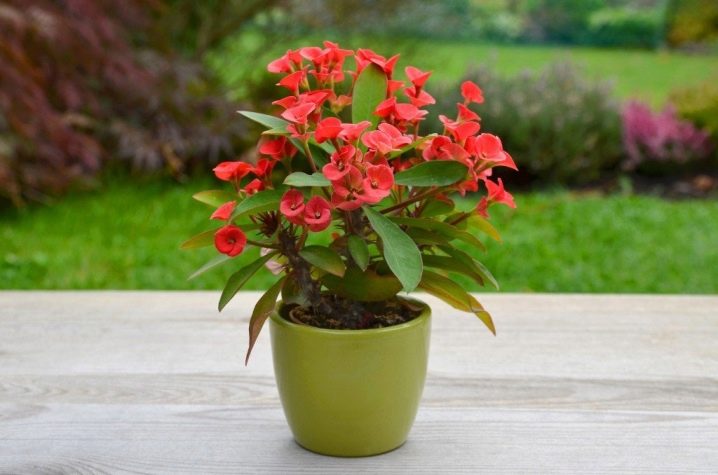
Another feature of this plant is the release of milky sap, poisonous in composition, which appears on broken off or accidentally cut leaves. Experts advise placing this flower out of the reach of children. Adults also need to handle the plant with care, as contact with milky juice causes irritation and, in severe cases, burns.
In nature, flowers of all types of milkweed are pollinated by insects. At home, such a pollination procedure can be done independently.
- Look closely at the flowers for euphorbia. It is important to distinguish between male flowers (they have higher stamens) and female flowers (fade faster, seemingly lower).
- Use a cotton swab or soft fluffy brush to transfer pollen from a male flower to a female one.
- After some time, the seeds ripen and fall to the surface of the plant soil.
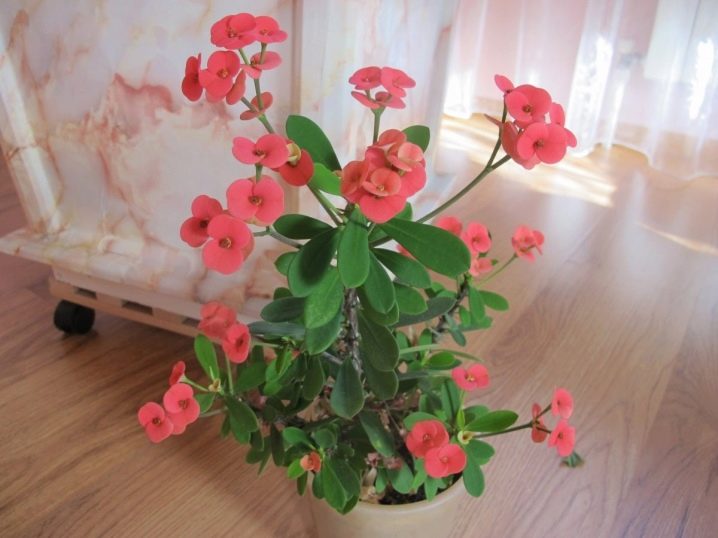
Planting and transplanting
Even for such an unpretentious flower as the Millet spurge, certain conditions must be met for planting and transplanting. This desert plant has a hard time getting moisture in hot, arid climates, so its root system looks like an elongated shaft with branched small roots. Hence, for him, the most comfortable will be a tall, narrowed down pot.
To prevent water stagnation and root decay, the planting container is filled with expanded clay. It can be replaced with damp pebbles or finely broken bricks.Then the pot is filled with soil, which can be collected on the garden plot.
But in order to achieve full development and long-term flowering, it is better to purchase a special substrate for succulents. It contains a balanced amount of nitrogen, phosphorus, potassium and trace elements.
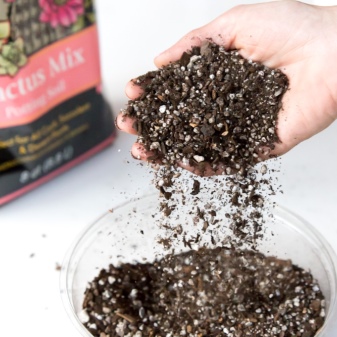
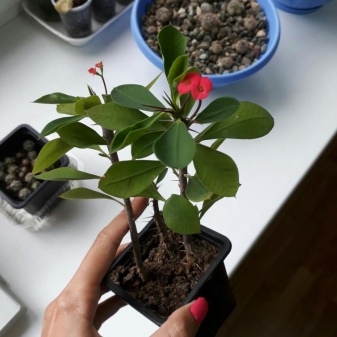
When the root system of milkweed grows, the planting capacity becomes small for him and the plant receives nutrients in smaller volumes. Therefore, the bush needs a transplant to create more favorable conditions for its development. Signs indicating the need for a transplant:
- watering is required more often, since the soil dries out faster due to the intensive growth of roots;
- small hairs of the roots make their way through the holes at the bottom;
- the appearance of harmful insects, larvae and infection in the root system;
- leaf blades turn yellow on the plant;
- long-term absence of flowering and the appearance of new shoots.
The best time for a milkweed transplant is during the warm season, when the growth process enters an active phase.
But there are exceptions. No need to transplant the plants that are producing flower buds, they should only be transplanted for the next warm season. Since milkweed are succulents, these types of flowers grow very slowly, which means they can "live" in one pot for a long time. On average, they are transplanted once every three years.
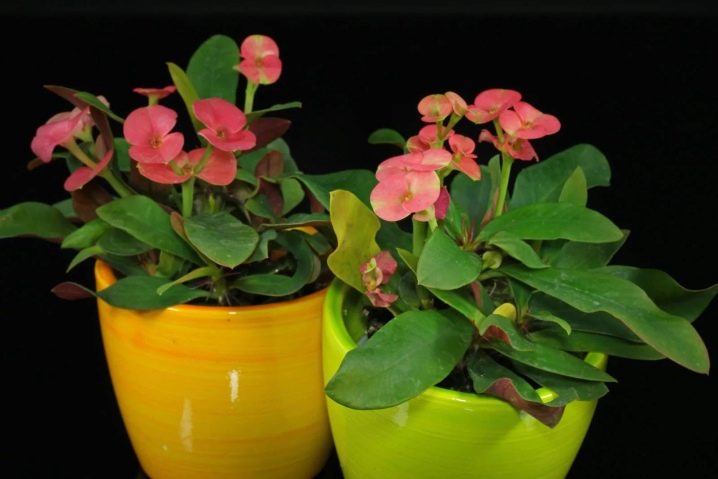
Long-standing flower growers try to carry out this procedure in accordance with the lunar calendar. During full moon periods, it is better not to touch flowers for transplantation, their survival rate will be poor. Favorable days for this fall on the growing moon, which is at this moment in Cancer, Taurus or Pisces. The transplant takes place in several stages, subject to certain rules.
- Spill the soil well the day before the procedure for more comfortable removal of the plant from the container.
- The new "dwelling" for a flower should be 2-3 centimeters higher and wider.
- A used container for a plant is poured over with boiling water.
- If the pot is earthenware, then it must be immersed in water for at least two hours in order to release all harmful substances through the smallest pores.
- Pour a drainage 3 centimeters high at the bottom of the pot. For this purpose, gravel, expanded clay are perfect, you can also use finely broken shards or coals.
- Next, you need to fill it with nutritious soil with high air permeability to the roots, with the required acidity of 4.5-6 pH. The height of the soil is 3-4 centimeters.
- Carefully remove the plant along with the earthy clod. If the ground is almost invisible visually due to the roots, feel free to change the place of residence of the flower.
- At the time of removing the "pet" from the pot, inspect its root system for pests and diseases.
- If there are larvae of harmful insects and infected areas, you need to shake off the ground, very carefully rinse the roots, first with water, then in any fungicide, following the instructions. In case of decay of the roots, remove the rotten areas, sprinkle the cut areas with ash or rinse in a solution of pink potassium permanganate.
- A plant is placed on top of the poured soil, free places are sprinkled with a light loose substrate. Lightly crush and watered. After a week, when the soil has settled, you can add fresh soil.
- Install pots with transplanted flowers on the shady side of an apartment or house for better adaptation. Return to a permanent place in 5-6 days.
- In the first month, reduce watering so that the roots spread and grow.
- The first doses of fertilizer should be applied no earlier than after 5-7 weeks.

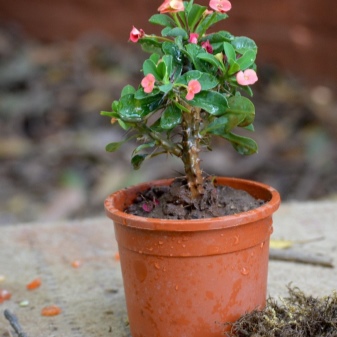
How to care?
For Milkweed Mil, you must follow several rules for home care.
All succulents are drought-resistant, which means they do not need abundant watering, but it depends on the season. In summer, twice a week is enough, in winter watering is more rare - 2-4 times a month as the top layer of the soil dries up. For milkweed, the main rule is that it is better to water less than pour. because waterlogging leads to decay of the root system and the plant dies.
Air humidity must be kept at a sufficiently low level with obligatory weekly ventilation. Spraying milkweed is not required.
In winter, the spurge will feel comfortable at temperatures between 15 and 18 degrees Celsius. In summer - from 20 to 25 degrees.
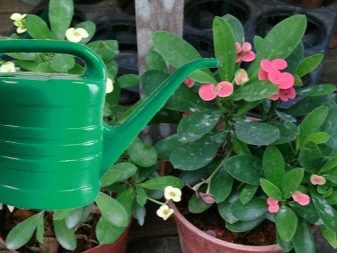

Euphorbia is not afraid of direct rays of the sun, which means it can be placed on the southern windowsill. In winter, additional illumination with conventional lamps or phytolamps is required for 12 hours. The second option is preferable, since the phytolamp stimulates plant growth, increases the flowering period. With a lack of lighting, the plants stretch out, the leaves fall off faster.
If you do not use a special substrate, then you can prepare the soil for planting yourself. You will need sand and sod land in one part, leaf land in two parts.
Used as fertilizer special preparations for succulents in an amount: nitrogen - 5%, potassium - 10%, phosphorus - 5%... Nitrogen helps build healthy greens. Potassium will help plants cope with temperature changes and lack of light. Phosphorus strengthens the root system, accelerates the formation of flower buds, and increases seed germination. Liquid fertilizers are better absorbed by plants.
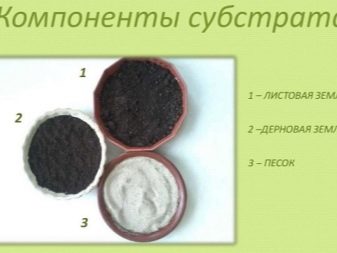

Pruning
Pruning is carried out at any time of the year, except for the autumn period. This can be done periodically, as soon as you decide that the spurge has outgrown and its "hair" is time to put in order. To form a beautiful lush crown, you must:
- in young shoots, pinch off the top of the shoot at a height of 10-15 centimeters;
- it is necessary to properly trim the lateral buds - they are removed in such a way that the new shoots take a horizontal position;
- the central stem of an adult plant is cut when it reaches the height you need;
- the process of emergence of new shoots can be accelerated by increasing the lighting.
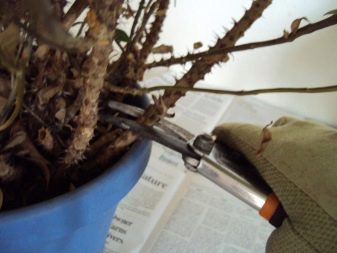
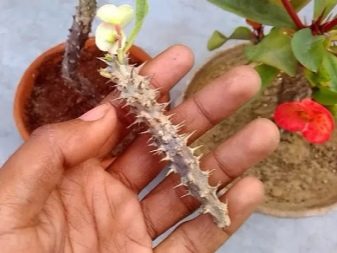
Reproduction
The easiest trick to propagate euphorbia is to divide the bush into several parts. In early spring, you need to get the plant out of the container, shake it slightly over the film. Then, with your hands, very carefully, pull the clod of earth together with the roots in different directions. The bush is usually divided into 2-3 parts. In this case, it is advisable not to use cutting objects. If the bush does not divide without them, then the knife or scalpel must first be sterilized.
Rinse fresh sections with water so that the juice stops faster, and sprinkle with ash. Plant the updated bushes in the prepared pots according to all the transplant rules. Since the euphorbia is stressed during this procedure, the first year it grows much slower and very rarely blooms.

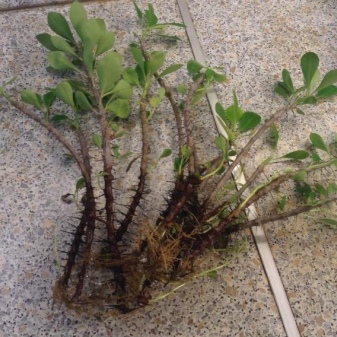
Seed breeding is done in a slightly different way. The collected seeds are sown in the previously shed soil and slightly pressed into the surface. The container is covered with plastic wrap, glass or a plastic bottle. Install it in a room where the temperature does not drop below 21 degrees Celsius. After the emergence of shoots, you need to transfer the container to the lightest windowsill, remove the shelter.
Water as the soil dries. When the seedlings reach a height of 5-7 centimeters, they are transplanted into permanent pots.
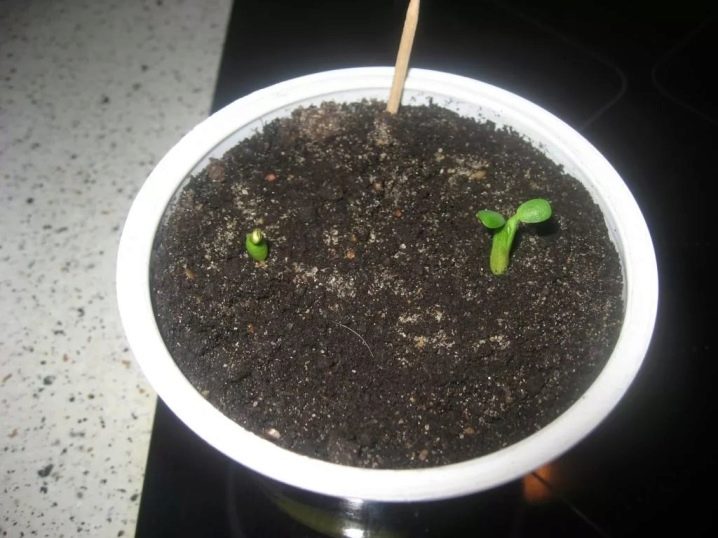
Euphorbia is easily propagated by cuttings. To do this, cut off the apical shoots no more than 5-7 centimeters long. Be sure to wash off the secreted milky juice with warm water. Fresh cuts should be dipped in crushed charcoal and put to dry for 3-4 hours. Plant the cuttings in prepared containers, spill abundantly and wrap them in plastic bags or cover with glass jars to create a greenhouse effect. The temperature regime for cuttings should not exceed 23 degrees Celsius.
The rooting period lasts approximately 14 to 17 days.
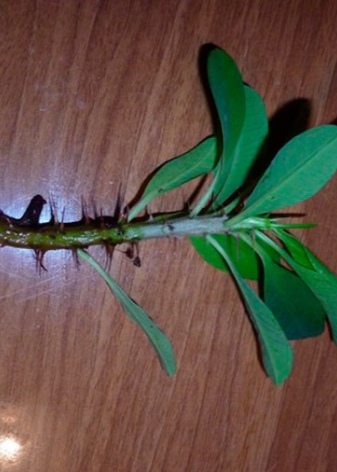

Pests and diseases
Mil's spurge is usually "loved" by such harmful insects as aphids, whiteflies and mealybugs.
- Mealybug. When damaged by a scale insect, the plant stops growing. The leaves first turn yellow, then dry up and fall off. Visually, when removing the plant from the pot, mealy accumulations can be seen in the area of the beginning of the root system. These are pests along with the products of their vital activity. If you ignore the disease, then the spurge dies.
To get rid of this infection, you need to get the plant out, disinfect the container, rinse the roots and spray with the Intavir solution according to the instructions.
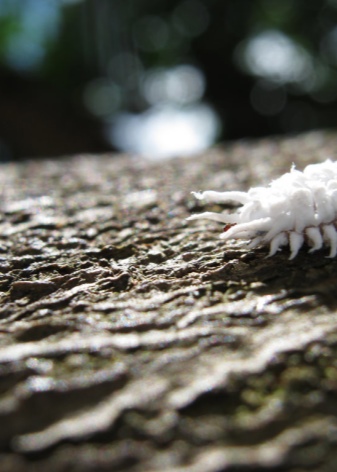

- Whitefly. The midge is white. It can be easily seen on the wrong side of the sheet. When the cell sap is sucked out, it leaves behind a sticky sugary discharge. To get rid of the whitefly, you just need to spray the bush with any insecticide, for example, "Fufan" or "Aktellik".

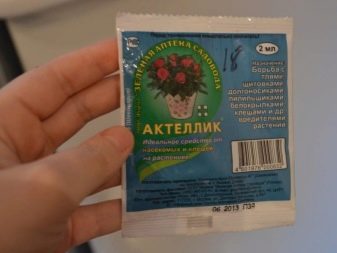
- Aphid. The insect is yellow or light green. Very quickly oppresses the plant. When damaged by aphids, the plant first turns yellow, and then sheds its leaves. These pests can be removed mechanically. Damaged shoots or leaves should be carefully trimmed and sprayed with insecticides.
If after the first treatment all insects have not disappeared, then spraying must be repeated until the pests completely disappear.

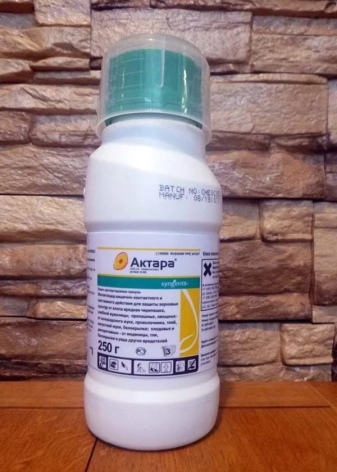
Among the diseases of Milkweed, the most common are the following.
- Gray rot. Caused by the fungus Botrytis Pers. It is transmitted with contaminated soil, through drops of water from a diseased plant, as well as through contact with infected milkweed. Signs are brown spots on the leaves that increase in size and spread over the entire surface of the leaf. If the humidity in the room is higher than normal, then a gray bloom additionally appears on these spots.
- Alternaria Signs: on the leaves, spots are from light to dark brown. Weakened old plants get sick faster.
- Root rot. On the border of the stem and root, dark spots of a depressed nature, which, growing, rise up the stem and destroy the tissues. The plant breaks and falls.
- Powdery mildew. It manifests itself in the form of a fluffy bloom on the leaf petioles and stem of the plant. Under such a bloom, brownish spots appear, which subsequently dry out. When infected in the last stage, the spurge dies.
- Bacteriosis Leaves and stems are strewn with weeping spots. Damaged areas emit a cloudy liquid with a pungent unpleasant odor. It gets on the plant through cuts, wounds and cracks.
- Mosaic... Speckled small specks of red-yellow and whitish shades appear on the leaves. The disease is transmitted through infected plants and by whiteflies.
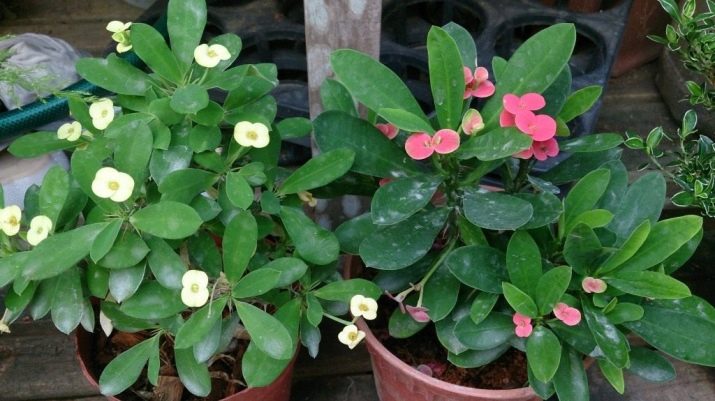
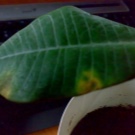
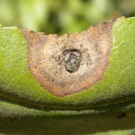
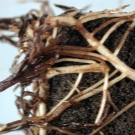

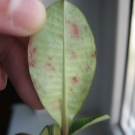
Causes of diseases:
- waterlogging of the soil;
- high environmental humidity;
- lack of ventilation;
- excess nitrogen in the soil.
Control and prevention measures:
- adjust watering, ventilation and air humidity;
- use healthy, high-quality soil for planting plants;
- if infected, treat with fungicides (Fundazol, Ridomil, Previkur, Topaz, Vitaros).
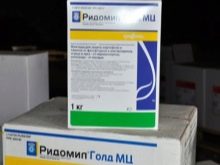

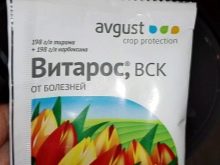
All about the proper care of Milkweed see below.























































The comment was sent successfully.